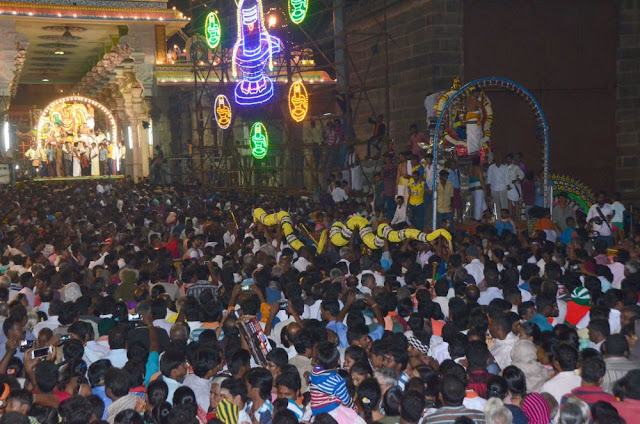Big Silver Rishba
“The Festival begins nine or ten days before Thibam. Each evening there are solemn processions round the Temple, which are over and above the regular worship and the private offerings of puja which go on through the day.
The day comes to its climax with the procession in the evening, which lasts almost until midnight. It is led by Ganapati, the commander of the heavenly hosts (gana-pati). Next comes Karttikeyi, the Lord of the Pleiades, also called Murugan (or Subrahmaniyan in Tamilnadu), who like Ganapati is a murti of Shiva and also his son . . . . There there is Uma or Parvati, Shiva’s consort; and lastly, on his white bull, Shiva Arunachala or Annamalaiyar. According to custom they are carried on the Temple cars, whose dimensions and decoration are on the grandest scale. Every evening there are different cars, each more impressive than its predecessor. Of these the most remarkable are the huge car of carved wood, more than ten metres high, on which the statue is carried on a day during the Festival and also the silver bull on which Shiva rides on the fifth day.
It was recommended not to miss the night of the silver bull, and I had accordingly arrived in very good time. I passed the time in the shrine of Sundareshwar, which was under the supervision of my friend Arunachala Aiyar, Ramana’s old companion in the Virupaksha cave. Saminathan was also there that evening. The mandapam was crowded with people who like us were waiting to see the procession. They plied me with endless questions, which I answered as well as I could. Saminathan, not knowing Tamil, remained silent, his eyes half shut, lost in his prayer. I have to admit that my questioners were much more impressed by Saminathan and his silence than by the answer that they sought to extract from me; but they paid even less attention to the disquisitions which which one or other of the company sought remorselessly to improve the occasion. They clearly told me so . .
During this time, in the Kalyana Mandapam, ‘the portico of weddings,’ the priests were busy decorating the murtis, using silk and gold brocade, flowers and valuable jewels. Meanwhile the cars were standing outside the Temple, and on them also ornaments were being loaded. All this seemed to go on interminably; but at last there was a sudden blare of trumpets form the inner courtyard, their sound re-echoing loudly from the high enclosure walls. Accompanying the trumpets was the low drone of the tamburas, while the silvery melody of flutes pierced though the noise of the crowd.
Now the file of murtis with their attendants emerged from their shrines, and when they passed under porticos or gopurams the echo from the low vaults become deafening. Soon they came to the Vallalla Gopuram where were were standing. In front were the torch-bearers, next the musicians, and last the palanquins, carried on the bare shoulders of the priest. On either side was the tightly-packed crowd with outstretched arms, giving cries of fervent devotion. Somewhere breaking coconuts on the ground, while others held out at arm’s length gilded trays of burning camphor. The enthusiasm spread, swelled, multiplied itself irresistibly. Light, heat, scents, sounds, bodies and souls too, all were weeded together into a single vast and vibrant outpouring of love in honour of the Lord of Arunachala.
We followed behind the procession, crossed the outermost courtyard, passed under the huge gopuram, passed under the huge gopuram over the East Gate and reached the long colonnade which adjoins it on the east, where the cars were waiting. The murtis were installed on the cars; and once again the work of decoration was resumed with renewed zeal; flowers, jewels, lights in even greater quantity. The crowd was now more tightly packed than ever. The friend who was guiding me managed to open a path for me immediately in front of the chief car, where the palanquin of Shiva Annamalaiyar was mounted on the silver bull.
Over him was held a huge ceremonial umbrella which touched the roof overhead. Behind the car was a trailer with a dynamo, and thousands of electric bulbs sparkled all over the palanquin, the platform, the decorations, among the jewels, silks and flowers which adorned the statue. Appusastri, who was standing near, was so moved that he cried out: “How can one doubt any longer that it is the Lord himself upon his car, who presents himself for our adoration!” Yet this Appusastri was an old disciple of Ramana and Ganapati Muni, who more than anyone had lectured me about advaita, proclaiming that whatever appears is maya, that there is no distinction at the heart of Being, and that it is vanity to worship God as an “Other” . . .!
[Narrative By Swami Abhishekananda 1970]
 |
| Aarti to Gods inside Kalyana Mandapam |
 |
| Adorning the Gods in front of the Alankaram Mandapam, outside Raja Gopuram (East Tower) |
 |
| Huge garlands for Lord Arunachaleswarar on the Big Silver Rishaba (bull) being passed over the head of devotees to the platform in front of the Alankaram Mandapam |
 |
| Brahmin priests arranging the huge garlands on Lord Arunachaleswarar and his vahana |
 |
| Huge umbrella has been placed over the adorned Lord on his Big Silver Rishaba |
 |
| The panchamoorthies giving darshan to devotees in front of the Alankaram Mandapam |
 |
| Starting off on their procession of the mada veedhis (4 perimeter streets) around Arunachaleswarar Temple |













































